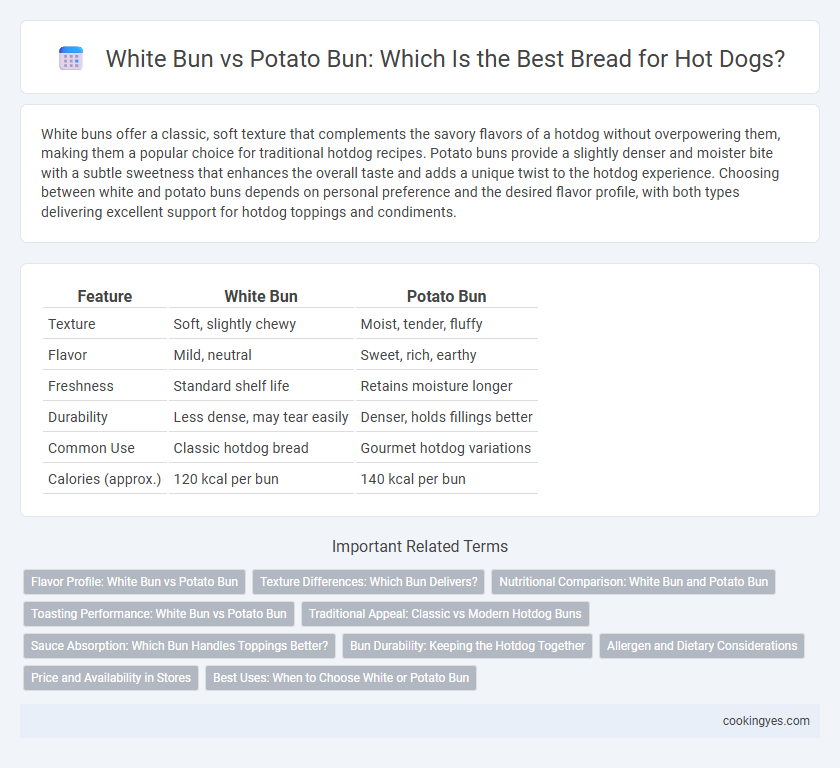White buns offer a classic, soft texture that complements the savory flavors of a hotdog without overpowering them, making them a popular choice for traditional hotdog recipes. Potato buns provide a slightly denser and moister bite with a subtle sweetness that enhances the overall taste and adds a unique twist to the hotdog experience. Choosing between white and potato buns depends on personal preference and the desired flavor profile, with both types delivering excellent support for hotdog toppings and condiments.
Table of Comparison
| Feature | White Bun | Potato Bun |
|---|---|---|
| Texture | Soft, slightly chewy | Moist, tender, fluffy |
| Flavor | Mild, neutral | Sweet, rich, earthy |
| Freshness | Standard shelf life | Retains moisture longer |
| Durability | Less dense, may tear easily | Denser, holds fillings better |
| Common Use | Classic hotdog bread | Gourmet hotdog variations |
| Calories (approx.) | 120 kcal per bun | 140 kcal per bun |
Flavor Profile: White Bun vs Potato Bun
White buns offer a classic, slightly sweet flavor with a soft, airy texture that complements the savory taste of hotdogs without overpowering them. Potato buns provide a richer, subtly earthy sweetness and a denser, moister crumb that enhances the overall flavor experience by adding a unique depth. Choosing between white and potato buns depends on whether you prefer a traditional, neutral base or a more flavorful, hearty bread to elevate your hotdog.
Texture Differences: Which Bun Delivers?
White buns offer a soft, pillowy texture with a slight chewiness that complements classic hotdogs by soaking up condiments without falling apart. Potato buns provide a denser, moister crumb with a subtle sweetness and sturdier structure, making them ideal for hearty, loaded hotdogs. Texture-wise, white buns excel in lightness and absorbency, while potato buns deliver durability and a rich, tender bite.
Nutritional Comparison: White Bun and Potato Bun
White buns typically contain refined wheat flour, resulting in lower fiber content and fewer micronutrients, while potato buns incorporate dehydrated potato flour, enhancing moisture and providing slightly higher potassium levels. Potato buns often have a softer texture and a marginally lower glycemic index compared to traditional white buns, making them a preferred option for those monitoring blood sugar. Nutritionally, potato buns may offer modest benefits such as increased vitamin C residue and mineral content, but both bun types remain relatively similar in calories and carbohydrates.
Toasting Performance: White Bun vs Potato Bun
White buns offer a crisp, golden texture when toasted, creating a sturdy yet soft base that complements juicy hotdog fillings. Potato buns exhibit superior moisture retention during toasting, resulting in a tender, slightly sweet bite that resists drying out under heat. The choice between white and potato buns impacts toasting performance by balancing crunchiness and moisture retention, essential for an optimal hotdog experience.
Traditional Appeal: Classic vs Modern Hotdog Buns
White buns offer a classic, soft texture and neutral flavor that perfectly complements traditional hotdog toppings, making them a staple at ballparks and backyard cookouts. Potato buns, with their moist crumb and slightly sweet taste, provide a modern twist that enhances gourmet hotdog creations while maintaining structural integrity. Both options cater to different preferences, with white buns appealing to nostalgic customers and potato buns attracting those seeking a richer, more indulgent bun experience.
Sauce Absorption: Which Bun Handles Toppings Better?
White buns typically have a softer, more porous texture, allowing them to absorb sauces and toppings more effectively without becoming overly soggy. Potato buns, made with potato flour, generally have a denser and moister crumb that resists soaking up sauces, which helps maintain structural integrity but limits sauce absorption. For hotdogs with heavy or liquid toppings like mustard or chili, white buns better balance absorbing flavors and holding toppings securely.
Bun Durability: Keeping the Hotdog Together
White buns offer a classic soft texture but may become soggy quickly when loaded with juicy toppings, affecting bun durability. Potato buns feature a denser, sturdy crumb that better withstands moisture, helping keep hotdogs intact during eating. Choosing potato buns enhances structural integrity, preventing the bun from falling apart under heavy condiments or grilled sausage juices.
Allergen and Dietary Considerations
White buns for hotdogs typically contain wheat gluten and may include additives like high fructose corn syrup, making them unsuitable for individuals with gluten intolerance or allergies. Potato buns often use potato flour and sometimes egg or dairy, requiring careful label checks for those with egg or milk allergies. Both options vary in allergen presence, so selecting gluten-free or allergen-specific breads is essential for safe consumption.
Price and Availability in Stores
White buns for hotdogs typically offer the lowest price point due to widespread production and basic ingredients, making them readily available in most grocery stores. Potato buns, while slightly more expensive, can be less common and might only be found in specialty food stores or specific supermarket chains. Consumers seeking affordability and convenience often opt for white buns, whereas potato buns appeal to those willing to pay a premium for a softer texture and richer flavor.
Best Uses: When to Choose White or Potato Bun
White buns are ideal for classic hotdogs and are best suited for traditional flavors like ketchup, mustard, and relish due to their soft texture and neutral taste. Potato buns offer a slightly sweeter, denser option, enhancing gourmet or specialty hotdogs with richer toppings such as caramelized onions, spicy sausages, or artisanal cheeses. Choosing between white and potato buns depends on the desired flavor profile and texture, with white buns complementing simple, traditional hotdogs and potato buns elevating bolder, more complex combinations.
White bun vs potato bun for hotdog bread Infographic

 cookingyes.com
cookingyes.com